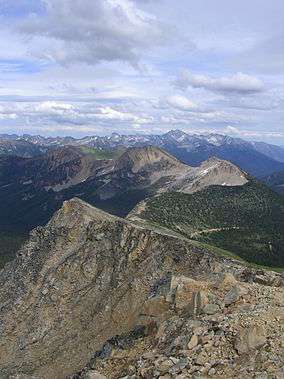Cascade Mountains leeward forests
| Cascade Mountains leeward forests | |
|---|---|
|
Stein Valley Nlaka'pamux Heritage Park | |
 | |
| Ecology | |
| Biome | Temperate coniferous forests |
| Bird species | 187[1] |
| Mammal species | 81[1] |
| Geography | |
| Area | 46,300 km2 (17,900 sq mi) |
| Countries | United States and Canada |
| Conservation | |
| Habitat loss | 0.6707%[1] |
| Protected | 43.48%[1] |
The Cascade Mountains leeward forests are a temperate coniferous forest ecoregion of North America, as defined by the World Wildlife Fund (WWF) categorization system.
Setting
This is a band of mountain habitat running north-south along the leeward side of the Cascade Mountains in British Columbia, Canada and Washington, United States, with the Okanagan Highland to the south on the US-Canada border and the Chilcotin Ranges to the north.[2]
This is a varied mountain landscape of rugged, snowy peaks, glaciers and alpine meadows. In the southern ranges the temperature varies from 15 °C (59 °F) in summer to −3.5 °C (26 °F) in winter with the northern ranges 2–3 °C (4–5 °F) cooler.
Flora
Higher elevation subalpine slopes are home to Engelmann spruce (Picea engelmannii), subalpine fir (Abies lasiocarpa) and lodgepole pine (Pinus contorta) while lower montane forests consist of lodgepole pine, quaking aspen (Populus tremuloides), white spruce (Picea glauca) and Rocky Mountain Douglas-fir.
Fauna
Wildlife of the mountains includes bighorn sheep (Ovis canadensis), mountain goat (Oreamnos americanus), grizzly bear (Ursus arctos) and American black bear (Ursus americanus), black-tailed deer (Odocoileus hemionus), coyote (Canis latrans) and cougar (Puma concolor)[2] with smaller mammals such as the northern flying squirrel. The birds include spotted owl, dusky grouse (Dendragapus obscurus) and a number of birds of prey. The Fraser River is particularly important for salmon and also acts as a barrier to the movement of wildlife within the region.
Threats and preservation
Most of this forest is still intact although threatened by logging, mining and other human intervention. Large blocks of intact forest include North Cascades National Park in Washington and the following areas of British Columbia; Big Creek Provincial Park and Spruce Lake Protected Area, the Stein Valley Nlaka'pamux Heritage Park, E. C. Manning Provincial Park, Ts'il?os Provincial Park, Cathedral Provincial Park and Protected Area, Skagit Valley Provincial Park, Marble Range Provincial Park, Cascade Recreation Area and Edge Hills Provincial Park near Fraser Canyon.
See also
References
- 1 2 3 4 Hoekstra, J. M.; Molnar, J. L.; Jennings, M.; Revenga, C.; Spalding, M. D.; Boucher, T. M.; Robertson, J. C.; Heibel, T. J.; Ellison, K. (2010). Molnar, J. L., ed. The Atlas of Global Conservation: Changes, Challenges, and Opportunities to Make a Difference. University of California Press. ISBN 978-0-520-26256-0.
- 1 2 "Cascade Mountains leeward forests". Terrestrial Ecoregions. World Wildlife Fund.
